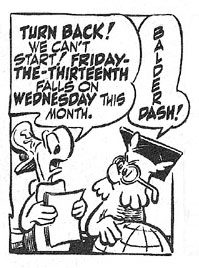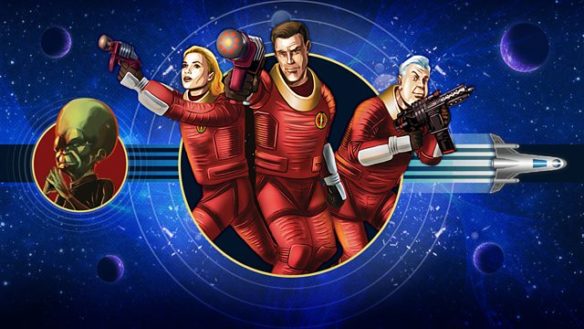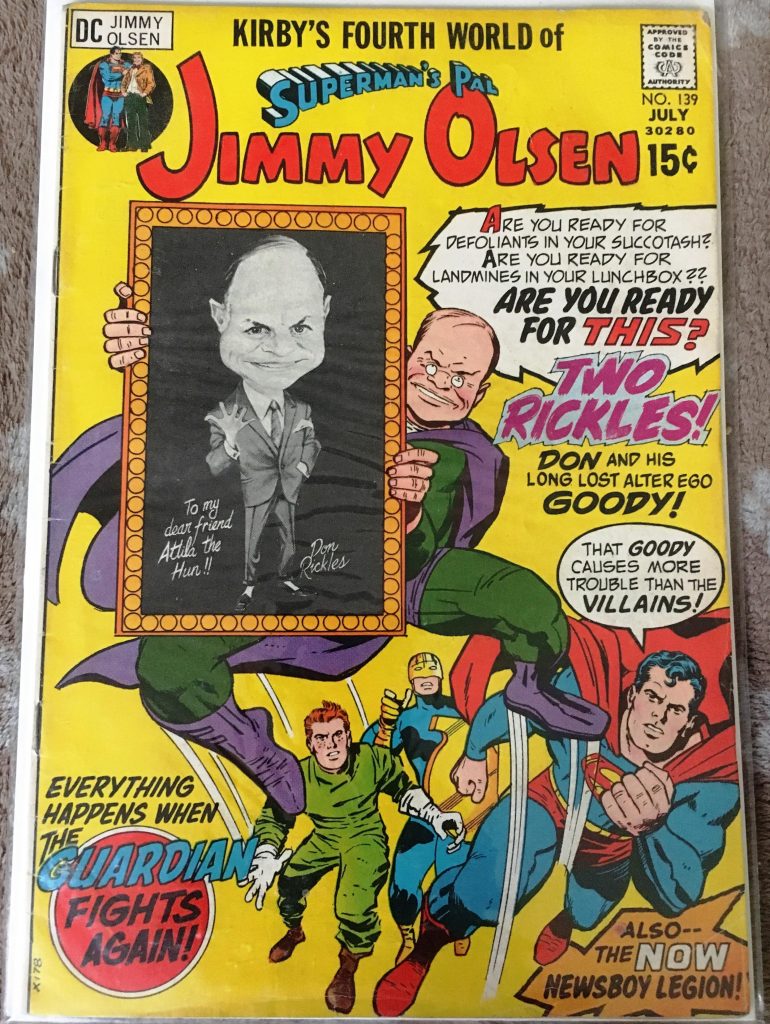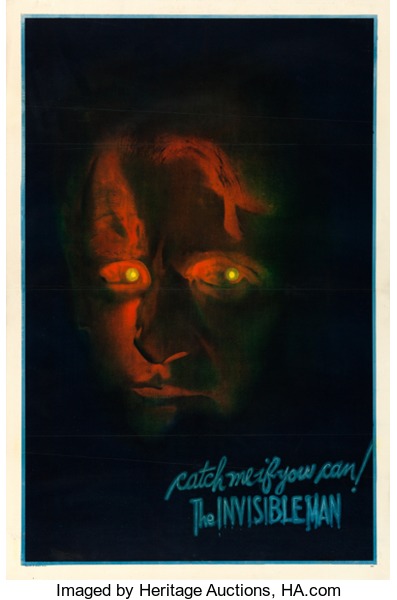(1) WORLDCON ENDS: FILM AT ELEVEN. Watching CoNZealand’s Closing Ceremonies brought back a memory —
When Winnipeg started its bid for the 1994 Worldcon, chair John Mansfield had everybody on the committee fill out a questionnaire about their interests. On the last day of the convention he returned these forms to everyone saying, “Okay. Here’s your life back.”
At today’s Closing Ceremonies the gavel passed to DisCon III’s Bill Lawhorn and Colette H. Fozard.

(2) TABLE SERVICE. Camestros Felapton illustrates an aspect of the 2020 Hugo Award nomination process in “EPH Fan Writer”.
… As each person is eliminated, the points get redistributed. By looking at the change in points for each surviving nominee, you can calculate the proportion of points that the survivor gets from the eliminated.
(3) THE PAST THROUGH TOMORROW. There are several good rundowns on the problems with last night’s Hugo Awards ceremony, including this one from Sean Reads Sci-Fi, “Uh-Oh, the Hugos Were a Hot Mess!”, which includes some good excerpts from the acceptance speeches.
…Some of the history was admittedly interesting, but I kept waiting for Martin to catch up to the present day, to illustrate how the long arc of the Hugos has bent toward justice, how the field continues to evolve to this day. He never did. He stayed rooted firmly in the past, and as the night wore on his stubborn refusal to acknowledge current movements in SF/F began to feel pointedly exclusionary rather than just incidentally so.
And I haven’t even mentioned the names! To mispronounce someone’s name live is one thing. As a teacher, I can attest to the fact that you will occasionally get someone’s name wrong on the first day. But (a) they had plenty of time to practice, (b) they almost certainly were given pronunciation guides by most authors, and (c) this doesn’t excuse the constant mispronunciations during pre-recoded segments, unless, of course, Martin refused to re-record them, which is its own set of problems. The folks behind the scenes should have done more to vet these segments, and should have pushed back harder when it became clear what Martin was doing.
What’s fascinating to me, though, is how the awards themselves drew such a sharp contrast to the nostalgic navel-gazing of the toastmaster. It really felt like the past and the future colliding – and the future won. Literally! The winners often talked about systemic problems within the industry, about the fights that we still have to fight, about the hard work that women, people of color, queer folks, and others have to do in order to even be considered alongside the white/cis/het fuddy-duddies running last night’s show. It was such a welcome breath of fresh air, for instance, when R.F. Kuang, one of the first winners, emphasized the barriers that she faced getting into the field:
If I were talking to a new writer coming to the genre in 2020, I would tell them, well, if you are an author of color, you will very likely be paid only a fraction of the advance that white writers are getting. You will be pigeon-holed, you will be miscategorized, you will be lumped in with other authors of color whose work doesn’t remotely resemble yours. Chances are very high that you will be sexually harassed at conventions or the target of racist micro-aggressions or very often just overt racism. People will mispronounce your name, repeatedly, and in public, even people who are on your publishing team. Your cover art will be racist, and the way people talk about you and your literature will be tied to identity and your personal trauma instead of the stories you are actually trying to tell. If I had known all of that when I went into the industry, I don’t know if I would have done it, so I think that the best way we can celebrate new writers is to make this industry more welcoming for everyone.
R.F. KUANG, ASTOUNDING AWARD FOR THE BEST NEW SF WRITER
This was refreshing precisely because it’s an aspect of the history of the awards and of the fandom in general that George R.R. Martin, in his endless panegyrics to days gone by, refused to even acknowledge. Pointing out the deep-rooted, structural, and personal racism and sexism at the heart of the industry isn’t a sign of ingratitude – it’s a sign of strength and resolve in the face of tough barriers. As Ng put it in her speech:
Pulling down memorials to dead racists is not the erasing of history, it is how we make history … It would be irresponsible for me to stand here and congratulate us as a community without reminding us that the fight isn’t over and that it extends well beyond the pages of our books … Let us be better than the legacies that have been left us. Let them not be prophecies. Let there be a revolution in our time.
JEANNETTE NG, BEST RELATED WORK
That revolution was in strong form last night, as most winners took the time to celebrate marginalized voices and denounce the forces that marginalized them in the first place. I keep coming back to Martine’s speech, as well – to the knife that hurts all the more because you loved it before it cut you. A trenchant description of an industry and a genre that many loved but were excluded from for so long. That is, thankfully, changing. Not fast enough to prevent last night’s debacle – but fast enough to allow for last night’s inspiring wins
(4) GRRM RESPONSE. George R.R. Martin has commented here on File 770 about some of the reports and criticisms in circulation, beginning with – https://file770.com/2020-hugo-awards/comment-page-2/#comment-1205393
Whoever is circulating the story that I was asked to re-record portions of my Hugo hosting to correct mispronounced names, and that I refused, is (1) mistaken, or (2) lying. Never happened.
CoNZealand did ask me to re-record three of my videos, all for reasons for quality control: poor lighting, poor sound, wobbly camera. I complied with their request on two of the videos, the two that opened the evening; I re-did those live from the JCC. (The originals had been done in my cabin on an iPhone, when we were just trying to get the hang of this thing). The third segment they wanted re-recorded was the bit about the Hugo trophy, where I had some fun with the juicer, the Alfie, and the like. In that case, we decided to stay with the first take, since I no longer had the props on hand and could not easily have reproduced what I’d done at the cabin, which everyone seemed to like.
There is also a story out there that I was provided with the correct phonetic pronunciations of all the names. That too is completely untrue….
(5) YOUR NEW HUGO LOSERS HOSTS. Who wouldn’t sign up for that?
(6) GROWING PAINS. Scott Edelman stirred up some memories that were called out by his sister-in-law in service of an anti-Vietnam War protest.
(7) LEM STORY DRAMATIZED. “Review: A Sci-Fi Classic Featuring a Multiverse of Stooges” comes recommended by a New York Times reviewer.
…You wouldn’t think that the 4-foot-wide by 8-foot-tall space, approximately the same shape as an iPhone screen, would be big enough for a play, let alone an avant-garde company. Yet the closet, only 2 feet deep, is one of the stars of Gelb’s Theater in Quarantine series, which since late March has produced, on a biweekly schedule, some of the new medium’s most imaginative work from some of its simplest materials. As in silent movies, clowning, movement and mime are usually part of the mix.
“The 7th Voyage of Egon Tichy,” which was livestreamed on Thursday evening and will remain available in perpetuity on Gelb’s YouTube channel, has all of those and then some. Based on a 1957 story by Stanislaw Lem, the Polish science fiction writer most famous for “Solaris,” it concerns an astronaut named Egon who, passing through a minefield of gravitational vortexes, is caught in a causal loop paradox that bombards him with innumerable (and insufferable) alternative selves.
Lem’s story is a satire of the infinite human capacity for self-defeat, with the various Egon incarnations bickering and undermining one another as the gyrations of space-time bend them into conflict. When “a meteor no bigger than a pea” pierces the ship’s hull, destroying the rudder, everyone has ideas about fixing it — but since it’s a two-man job, making cooperation essential, nothing actually gets done.
(8) HEARING A DISCOURAGING WORD. Entertainment Weekly’s Darren Franich asks “Why are all these science-fiction shows so awful?”
Science fiction was once a niche TV commodity, but March brought three major live-action genre projects. Star Trek: Picard finished its debut season on CBS All Access. FX shared Devs with Hulu, pitching the miniseries as prestige bait for the chattering class. Season 3 of Westworld was HBO’s new hope for a buzzy, sexy-violent epic. And they were all terrible….
I get it: We are all scared of phones, and bots, and the Algorithm. Yet by demonizing technology, these projects oddly exonerate the people behind that technology. CEOs with tragic origin stories in Westworld or Devs are puppets for machines they can’t control. Higher-tech powers in Brave New World and “You May Also Like” control whole civilizations comprised of unaware humans.
(9) LIBRARIES TAKE HEAT IN CANADA. Publishers Weekly has the story:“Canadian Libraries Respond to ‘Globe and Mail’ Essay Attacking Public Libraries”.
[Intro] Editors Note: In a nearly 3,000 word opinion piece published on July 25 in ‘The Globe and Mail’ Kenneth Whyte, publisher of Toronto-based indie Sutherland House Books, pinned the troubles of Canada’s independent bookstores and publishers on the work of public libraries….
Publishers Weekly reprinted the Canadian Urban Libraries Council’s response:
… It is otherwise hard to understand why public libraries are to blame when bookstores and libraries have coexisted harmoniously and supported each other for decades.
So what’s changed? While there are a lot of changes that point to shifts in the marketplace, such as the research identifying a decline in leisure reading, coupled with less and less space for literary reviews in major news outlets, these are minor compared to the two major developments that have dramatically altered the book and reading landscape—and they have nothing to do with public libraries. First is the explosive growth in popularity of e-books and digital audiobooks. Second, is the increasing dominance of Amazon in the book retail and publishing marketplace.…
(10) MEDIA BIRTHDAY.
- August 1, 1986 — Howard The Duck premiered. Directed by Water Huyck and produced by Gloria Katz who were also the screenplay writers. George Lucas was executive producer. Its human stars were Lea Thompson, Jeffrey Jones and Tim Robbins. Howard The Duck was Ed Gale in the suit with the voice being Chip Zien. Critics almost unanimously hated it, it bombed at the box office, and audience reviewers at Rotten Tomatoes currently give it a 38% rating. It would be the last Marvel Film until Captain American twenty-one years later. (CE)
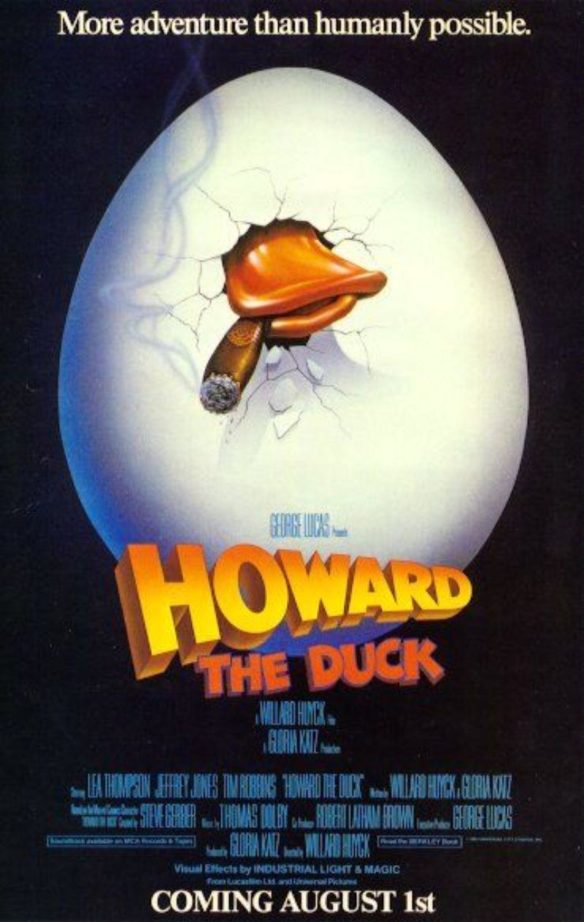
(11) TODAY’S BIRTHDAYS.
[Compiled by Cat Eldridge and John Hertz.]
- Born August 1, 1819 – Herman Melville. Without debating – though some do – how far Moby-Dick is fantasy, we can claim some more clearly – hmm, maybe not the best word with this writer – anyway, “Bartleby”, “The Tartarus of Maids”, “The Encantadas”, let’s say nine or ten. John Clute would include The Confidence-Man. (Died 1891) [JH]
- Born August 1, 1898 – William Ziff. I mean Ziff Sr., though Ziff Jr. is noteworthy too. The elder was the Ziff in Ziff-Davis Publishing, which took over Amazing from Hugo Gernsback, added Fantastic Adventures, comics with art director Jerry Siegel and e.g. John Buscema. I happen to think this cover for Weird Adventures 10 is feminist – look how the man is fascinated while the woman with him knows they should fear – but then I think Glory Road is feminist, and how many see that? (Died 1953) [JH]
- Born August 1, 1910 — Raymond A. Palmer. Editor of Amazing Stories from 1938 through 1949. He’s credited, along with Walter Dennis, with editing the first fanzine, The Comet, in May, 1930. The secret identity of DC character the Atom as created by genre writer Gardner Fox is named after Palmer. Very little of his fiction is available in digital form. (Died 1977.) (CE)
- Born August 1, 1914 – Edd Cartier. Oh, how great he was. Eventually we put him on two Retrospective Hugo ballots. We think of him as a comedian; true enough, but see this cover for Foundation and Empire. Vince Di Fate knew; see his treatment of EC in Infinite Worlds. World Fantasy Lifetime Achievement Award. (Died 2008) [JH]
- Born August 1, 1923 — Alan Yates. Though better known under the Carter Brown name where he wrote some one hundred and fifty mystery novels, I’m noting him here for Booty for a Babe, a Fifties mystery novel published under that name as it’s was set at a SF Convention. (Available from the Kindle store.) And as Paul Valdez, he wrote a baker’s dozen genre stories. (Died 1985.) (CE)
- Born August 1, 1930 — Geoffrey Holder. Best-remembered for his performance as Baron Samedi in Live and Let Die but he’s also the narrator in Tim Burton’s Charlie and The Chocolate Factory. He was also Willie Shakespeare in Doctor Doolittle but it’s been so long since I saw the film that I can’t picture his character. And he was The Cheshire Cat in the Alice in Wonderland that had Richard Burton as The White Knight. (Died 2014.) (CE)
- Born August 1, 1945 – Yvonne Rousseau, 75. Author, editor, critic, long-time fan. Australian SF Review, 2nd Series with J. & R. Blackford, Foyster, Sussex, Webb. Three short stories and a novelette. Contributor to Banana Wings, Chunga, Flag, Foundation, Journey Planet, The Metaphysical Review, Riverside Quarterly, SF Commentary, SF Eye. Fan Guest of Honour at ConFictionary, where the fire alarm went off and the hotel actually was on fire. [JH]
- Born August 1, 1954 — James Gleick, 66. Author of, among many other books, Genius: The Life and Science of Richard Feynman and What Just Happened: A Chronicle from the Electronic Frontier, and he is one of us in that he writes genre reviews which are collected in Time Travel: A History. Among the works he’s reviewed are Le Guin’s “Another Story or A Fisherman of the Inland Sea” and Heinlein ‘s “By His Bootstraps”. (CE)
- Born August 1, 1955 — Annabel Jankel, 65. Director who was first a music video director and then the co-creator and director of Max Headroom. She and her partner Rocky Morton first created and directed The Max Talking Headroom Show, a mix of interviews and music vids which aired on Channel 4 and HBO. Jankel and Morton would go on to direct Super Mario Bros. And they’re both responsible for the Max Headroom movie and series. (CE)
- Born August 1, 1969 – Dirk Berger, 51. Five dozen covers, a score of interiors. Here is Sucker Punch. Here is Empire Dreams. Here is Nova 23. Here is his Website. [JH]
- Born August 1, 1979 — Jason Momoa, 41. I knew I’d seen him before he showed up as Aquaman in the DC film franchise and I was right as he was Ronon Dex on Stargate Atlantis for its entire run. He was also Khal Drogo in the first season of A Game of Thrones. And not surprisingly, he was the title character in Conan the Barbarian. (CE)
- Born August 1, 1993 – Tomi Adeyemi, 27. Children of Blood and Bone, Children of Virtue and Vengeance, both NY Times Best Sellers. Norton Award, Waterstones Book Prize, Lodestar Award. Parents thought she’d be better off if they didn’t teach her their native tongue (they’re Yoruba), so with an honors degree from Harvard she got a fellowship to study it in Brazil. Website here. [JH]
(12) COMICS SECTION.
- Non Sequitur offers a suggestion on how to get started on that post-apocalyptic novel.
(13) BE PREPARED. A Public Service Announcement from the Dread Pirate Roberts channeling Inigo Montoya.
(14) ADVICE FOR SFF POETS. Veteran editor of Star*Line and Mobius: A Journal for Social Change “gives some surprising insights on submissions” in this interview conducted by Melane Stormm at SPECPO.
A must watch for any writer, but especially if you identify as female or if you’re feeling hesitant to submit your work someplace.
(15) ON BRADBURY’S SHELVES. The second installment of Phil Nichols’ Bradbury 100 podcast had dropped.
My guest is Jason Aukerman, Managing Director of the Center for Ray Bradbury Studies. The “Bradbury Center”, as it’s known for short, is the place where Ray’s working papers are held in archive, along with the contents of Ray’s personal library, and many of his professional and personal artefacts such as awards, videotapes and film prints.
(16) BALESTRIERI JOINS READ-A-THON. A Bradbury Read-A-Thon is planned as part of the author’s centenary celebration: “Iowan to join top authors, celebs in sci-fi ‘read-a-thon’” RadioIowa has the story.
A library curator at the University of Iowa will join “Star Trek” actor William Shatner and a list of other celebrities, authors and science fiction experts in a Ray Bradbury Read-a-thon next month. The event on August 22nd will mark what would have been the famed author’s 100th birthday.
Peter Balestrieri, curator of science fiction and popular culture collections at the UI Libraries, says he’s thrilled to be taking part.
“The Read-a-thon will be about 40 people reading segments of Ray Bradbury’s famous novel, ‘Fahrenheit 451,’” Balestrieri says. “All of the clips from all of the different readers will be put together into one seamless audio-visual book.”
Balestrieri will read a six-minute portion of the book as part of the roughly-four-hour event. Top sci-fi authors who will also read aloud include Neil Gaiman, Marjorie Liu and Steven Barnes, as well as former NASA administrator Charles Bolden.
(17) THAT’S NOT GOOD NEWS. “Nasa: Mars spacecraft is experiencing technical problems and has gone into hibernation, space agency says” at Yahoo! News.
Nasa‘s Mars spacecraft is experiencing technical problems and has sent itself into hibernation, the space agency has said.
The spacecraft was sent to space Thursday in a launch that had no technical problems – even despite an earthquake that struck just before liftoff, and a preparation period that came during the coronavirus outbreak. Shortly after it was launched, Nasa announced that it had received its first signal from the spacecraft.
But soon after it was in space and headed towards Mars, it became apparent that something had gone wrong with the craft. After that initial signal, mission controllers received more detailed telemetry or spacecraft data that showed there had been a problem.
The signal, which arrived on Thursday afternoon, showed that the spacecraft had entered a state known as “safe mode”. That shuts down all but its essential systems, until it receives new messages from ission control.
The hibernation state is intended to allow the spacecraft to protect itself in the case of unexpected conditions, and will be triggered when the onboard computer receives data that shows something is not as expected.
Nasa’s engineers think that the state was triggered because part of the spacecraft was colder than expected while it was still in Earth’s shadow. The spacecraft has now left that shadow and temperatures are now normal, Nasa said in an update.
Mission controllers will now conduct a “full health assessment”, the space agency said, and are “working to return the spacecraft to a nominal configuration for its journey to Mars”.
(18) TOLKIEN SAYS. At BookRiot: “28 J.R.R. Tolkien Quotes From His Books, Essays, And Letters”.
“‘I wish it need not have happened in my time,’ said Frodo.
‘So do I,’ said Gandalf, ‘and so do all who live to see such times. But that is not for them to decide. All we have to decide is what to do with the time that is given us.’” —The Fellowship of the Ring
(19) NAVIGATING ON VIRTUAL SEAS. Mlex reports on the Cyberpunk Culture Con (July 9-10), with some commentary on other virtual cons (BaltiCon, ConZealand, Fantastikon): “Cyberpunk Culture Conference”.
…I want to report on the recent virtual con, the Cyberpunk Culture Conference (Jul 9-10, 2020), which managed to swim perfectly through the fantastic milieu of the future that has already become the past, and floated out from the wreckage on that frenzied ouroboros of possibility waves as easily as a swimmer takes to an inflated tire inner tube on a summer pond.
The conference sprang up around recent books published by Routledge, which are quite excellent, I should add…
(20) 3D. [Item by Daniel Dern.] Great article about racing and 3D printing — “3-D Printing, a Boon for Racers, Inches Closer for Carmakers” — in the New York Times. Here’s two key ‘graphs from the top:
The Belgian racing team Heli had an engine problem. Specifically, under race conditions, the manifold of the four-cylinder turbo diesel in its BMW 1-series exploded, bursting along an ultrasonically welded seam that held together the manifold’s two halves.
…In 2018 Heli took the problem to ZiggZagg, a Belgian company that fabricates parts using an HP 3-D printer. ZiggZagg made a digital scan of the two-piece manifold and after 10 hours had a digital blueprint for a stronger, lighter, one-piece manifold. In its first race with the new manifold, printed using what is known as PA 12 nylon, the part held up and Heli took third. That same manifold lasted until the car was retired earlier this year.
(21) THE DRAGON RETURNING – MAYBE. NPR reports “Astronauts Set To Return To Earth In First U.S. Splashdown In Decades”.
The two astronauts that blasted off in the first private space vehicle to take people to the International Space Station are about to return to Earth — by splashing down in the waters around Florida.
This will be the first planned splashdown for space travelers since 1975, although a Russian Soyuz capsule did have to do an emergency lake landing in 1976.
NASA astronaut Douglas Hurley says that he and his crewmate Robert Behnken are prepared for the possibility of seasickness.
“Just like on an airliner, there are bags if you need them. And we’ll have those handy,” Hurley said in a press conference held on Friday, while on board the station. “And if that needs to happen, it certainly wouldn’t be the first time that that’s happened in a space vehicle. It will be the first time in this particular vehicle, if we do.”
The astronauts will come home in the same SpaceX Dragon capsule that took them up on May 30. Their flight marked the first time people had been launched to orbit from U. S. soil since NASA retired its space shuttles in 2011.
The success of their trip in the SpaceX vehicle has been a major milestone for commercial space travel, and a vindication of NASA’s long-term plan to rely on space taxis for routine flights to and from the orbiting outpost—while the government agency focuses on developing vehicles for a return to the moon.
The current plan is for the Dragon “Endeavour” capsule to undock from the International Space Station on Saturday at 7:34 p.m. ET, with scheduled splashdown at 2:42 p.m. ET on Sunday. There are potential splashdown zones both in the Atlantic and the Gulf of Mexico. With a hurricane headed towards Florida, however, it’s unclear if the weather will cooperate with the plan.
(22) VIDEO OF THE DAY. “Virtual Viewing: Disney’s Cruise Line’s Tangled, The Musical” on YouTube is an hour-long musical, with three songs composed by Alan Menken, that was performed on Disney’s Cruise Line and is worth seeing for people who need a Disney musical fix. (Hat tip to Mark Evanier.)
[Thanks to Darrah Chavey, Mike Kennedy, John King Tarpinian, Martin Morse Wooster, Michael Toman, John Hertz, Chip Hitchcock, Daniel Dern, Mlex, Cat Eldridge, JJ, and Andrew Porter for some of these stories. Title credit goes to File 770 contributing editor of the day Kip Williams.]

